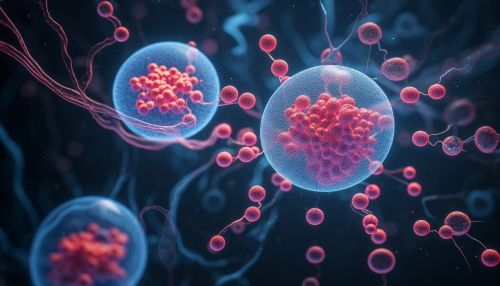Bacterial conjugation
Introduction
Bacterial conjugation is a type of genetic recombination that occurs in bacterial cells, allowing them to exchange genetic material via direct cell-to-cell contact. This process, first discovered in the bacterium E. coli, is a primary method of genetic variation in bacteria and plays a significant role in the spread of antibiotic resistance among bacterial populations.


Mechanism of Bacterial Conjugation
Bacterial conjugation involves the transfer of a copy of a plasmid, a small, circular piece of DNA that is separate from the bacterial chromosome, from a donor cell to a recipient cell. The donor cell, also known as the F+ cell, contains the fertility plasmid (F plasmid) that codes for the formation of a sex pilus, a thin tube-like structure that connects the donor and recipient cells during conjugation. The recipient cell, or F- cell, does not contain the F plasmid.
The process of bacterial conjugation begins when the F+ cell forms a sex pilus that attaches to the F- cell. The pilus then retracts, drawing the two cells together. Once the cells are in contact, the F+ cell forms a conjugation bridge, a channel through which the plasmid DNA can be transferred. The F+ cell then replicates its F plasmid using the rolling circle replication mechanism, and a single-stranded copy of the plasmid is transferred through the conjugation bridge to the F- cell.
Once inside the F- cell, the single-stranded plasmid DNA is converted into a double-stranded DNA molecule, and the cell becomes an F+ cell, capable of transferring the F plasmid to other F- cells. This process of plasmid transfer and conversion of F- cells to F+ cells can continue indefinitely, leading to the spread of the F plasmid throughout a bacterial population.
Role in Antibiotic Resistance
Bacterial conjugation plays a significant role in the spread of antibiotic resistance among bacterial populations. Antibiotic resistance genes are often located on plasmids, which can be transferred from one bacterium to another via conjugation. This allows bacteria to rapidly acquire resistance to multiple antibiotics, a phenomenon known as multiple drug resistance.
When a bacterium carrying a resistance plasmid comes into contact with an antibiotic, the antibiotic kills the sensitive bacteria, but the resistant bacterium survives and continues to multiply. As it multiplies, it can transfer the resistance plasmid to other bacteria via conjugation, spreading the resistance throughout the bacterial population. This process can occur rapidly, leading to the emergence of antibiotic-resistant bacterial strains in a relatively short period of time.
Conjugation in Gram-Negative and Gram-Positive Bacteria
Bacterial conjugation occurs in both Gram-negative and Gram-positive bacteria, but the mechanisms are somewhat different. In Gram-negative bacteria, the F plasmid codes for the formation of a sex pilus, which is used to establish contact between the donor and recipient cells. In Gram-positive bacteria, however, no sex pilus is formed. Instead, the donor and recipient cells come into direct contact, and the plasmid DNA is transferred across the cell membranes.
Despite these differences, the basic process of plasmid transfer and conversion of recipient cells to donor cells is the same in both Gram-negative and Gram-positive bacteria. In both cases, the process leads to the spread of the plasmid and any associated genes, such as antibiotic resistance genes, throughout the bacterial population.
Regulation of Conjugation
The process of bacterial conjugation is tightly regulated by a number of factors. These include the presence or absence of recipient cells, the nutritional status of the donor cell, and the presence of certain chemical signals. For example, the F plasmid contains a set of genes known as the tra (transfer) genes, which are responsible for the formation of the sex pilus and the conjugation bridge. The expression of these genes is controlled by a regulatory protein called TraM, which binds to a specific sequence on the F plasmid and initiates the transcription of the tra genes.
In addition to these internal regulatory mechanisms, bacterial conjugation is also influenced by external factors, such as temperature, pH, and the presence of certain chemicals. For example, conjugation is often inhibited at low temperatures or in the presence of high concentrations of divalent cations, such as calcium or magnesium.
Implications and Applications
The ability of bacteria to exchange genetic material through conjugation has significant implications for our understanding of bacterial evolution and the spread of antibiotic resistance. It also has potential applications in genetic engineering and biotechnology. For example, conjugation can be used to introduce new genes into bacterial cells, a process known as transformation. This can be used to produce bacteria that are capable of synthesizing useful substances, such as insulin or other pharmaceuticals.
